The Year’s Best
Molly Templeton & Jason Blair Pick the Top Movies of 2009
Jason – If box office receipts are a referendum on the national mood, 2009 was the year we played it safe. We craved the familiar in the form of sequels (Twilight and Harry Potter), and we sought comfort, mostly in cartoons. The one film everyone saw, Avatar, is essentially a muscled up FernGully; the only challenge the film offered was whether to see it in 2D when the 3D show was sold out. Meanwhile, the film we all agreed upon was Up, which, being a Pixar film, is about the safest bet in movies today. Films like Up and Avatar at least gave us something to talk about, unlike their brethren Transformers 2 and Twilight: New Moon, from which people emerged shaking their heads.
In 2009, the directors of Pulp Fiction, Erin Brockovich, Juno, Fargo and The Royal Tenenbaums were all back, in almost every case delivering the best films of their careers. It was an assemblage of talent moviegoers rarely see, yet only Tarantino’s Inglourious Basterds cracked the box office top 35. It makes me wonder if the films that need to reach you aren’t reaching you. Maybe you aren’t reaching out to them. The list below is designed to inspire debate, first, and second to provide a few breadcrumbs for those of you who want to join the conversation.
1. FANTASTIC MR. FOX
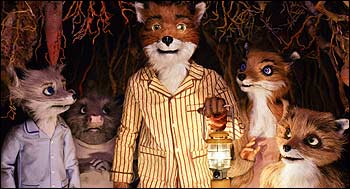 |
An unlikely, low-key masterpiece, Fantastic Mr. Fox is arguably Wes Anderson’s best film. It’s quietly confident, openly weird and sure to be remembered as one of the best children’s films ever. Its greatest virtue is how easily it lulls you into believing that foxes, not to mention people, can walk, talk and carry on like effete citizens, albeit ones with occasional wild streaks. Based upon the Roald Dahl story about trying to act civilized when your insides are crying out for wildness, it improves upon Where the Wild Things Are by emphasizing story over costumes. Nothing about it is realistic, yet everything in it is true. (12/3/09)
2. GOMORRAH
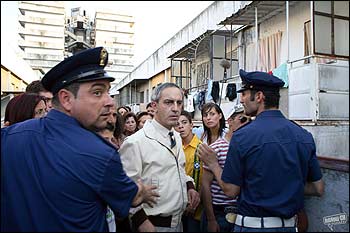 |
A gritty and panoramic gangster epic, Gomorrah is about the Camorra crime syndicate along the mean streets of Naples, Italy. Packed with real gangsters and shot documentary style, Gomorrah is based upon a book whose author went straight into protective custody. This is a mulitigenerational saga without the sheen of The Sopranos or the Godfather films: Gomorrah is about teenagers who vie for a piece of the action and the mothers who mourn them; the Mafia’s reach into industries from haute couture to toxic waste disposal; and about old men trying to stay relevant in a world that’s quickly passing them by. It’s bleak, tender, precise and brutal. It has to be considered among the best Mafia films ever. (4/9/09)
3. A SERIOUS MAN
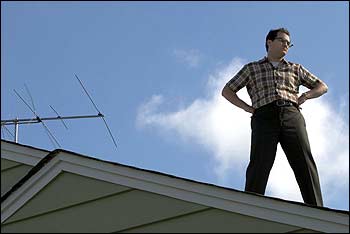 |
A tale of middle age anguish told with grace and understanding. On the verge of his tenure review, mathematics Professor Larry Gopnik (Michael Stuhlbarg) faces a series of Job-like crises: a daughter who steals from his wallet, a son who’s discovered marijuana, a brother who’s a permanent houseguest and a wife who wants to divorce him for a sanctimonious, close-talking neighbor. The Tony-award winning Stuhlbarg is a master of exasperation; I was spellbound by his resilience, by his attempts to persevere. Set in 1967 in the Minneapolis neighborhoods of their youth, A Serious Man may be the Coen brothers’ most personal film. If you’ve ever felt assaulted by forces beyond your control or wanted answers when none were available, this is a film for you. (10/29/09)
4. BRIGHT STAR
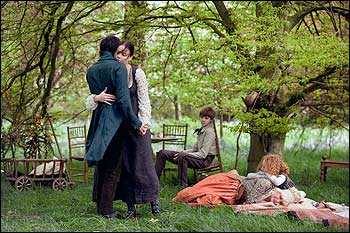 |
Bright Star is the most convincing and credible period drama in recent memory. Not because it underplays the period details, which it does to unadorned perfection, but because of the way it assembles itself out of universal material like poverty, illness and self-doubt. Still, it is a lovely and warm version of the John Keats-Fanny Brawne love affair, in which Ben Whishaw is the subdued poet and Abbie Cornish a talented seamstress. It resounds because it is so quiet. A film of drowsy perfection, Bright Star adheres to the delicate nature of their relationship: Keats cannot afford to marry his great love, which in 1820 was the end of it. Brawne’s character isn’t mere dressing here; she is every bit the equal of the greatest Romantic poet. This is the year’s best-looking film (along with The White Ribbon) with the best original score. (10/22/09)
5. UP IN THE AIR
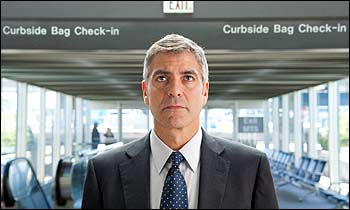 |
Up in the Air’s Ryan Bingham (George Clooney) is a man without connections. He’s the guy you hire when it’s time to fire someone — and business has never been better. Fastidious and emotionally minimalist, his life is what he fits into his backpack. Enter Alex, a similarly avid traveler with an enormous personal secret, and Natalie, who threatens to disrupt Ryan’s routines. Vera Farmiga plays Alex as deep, sultry and sweet, and Anna Kendrick is the perky know-it-all you love to hate. (Both are nominated for Oscars, along with Clooney.) Jason Bateman, who’s been indispensible for years, is at his slick, unflappable best. A mature and moving film, Up in the Air is about breaking routines that need to be broken — and trying to find your way home. (12/31/09)
6. INGLOURIOUS BASTERDS
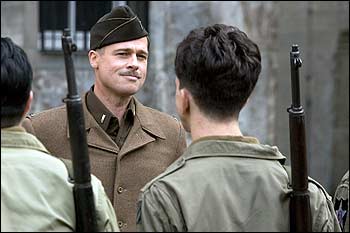 |
A movie about two different plots, one by Americans and the other by the French, to end WWII by burning down a cinema with Adolf Hitler inside. This being a Tarantino film, Inglourious Basterds is ferocious and extravagant, but it’s also crisp, organized and fun. The immense historical framework of WWII, which could have muddied Tarantino’s purposes, instead sharpens them to flinty perfection, allowing his antics more effective and subversive play than ever before. Like Pulp Fiction, Basterds teems with huge personalities, but in Basterds these villains were real once and, in this revisionist tale, Tarantino serves his revenge hot. Flaming hot. (8/27/09)
7. AN EDUCATION
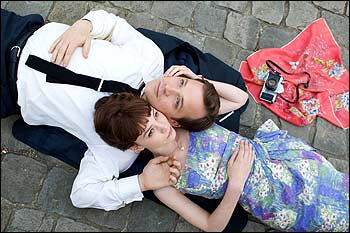 |
In An Education, Peter Sarsgaard is David Goldman, a cultured crook who seduces the much younger Jenny Mellor (Carey Mulligan), a shy but determined student of 16. Adapted by Nick Hornby, this is a story about youthful innocence and rebellion in stifling 1960s Britain. An Education is a showcase for relative newcomer Mulligan, who deserves an Oscar for playing a girl who can’t wait to meet “people who know lots about lots.” Mulligan undergoes a total transformation from naïve schoolgirl to sophisticate — and back again. The entire production feels authentic, from the wardrobes to provincial outlook. An immensely rewarding film experience that gets better with every viewing. (11/19/09)
8. IN THE LOOP
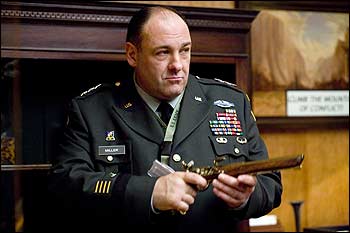 |
The nastiest satire in years, In the Loop is a re-imagining of the run-up to the invasion of Iraq. It’s an account exceeded in absurdity only by the actual events themselves. In the film, a hodgepodge of government officials, all nitwits, makes a series of low-level decisions that lands a coalition of forces in Iraq. I had an almost physical reaction to In the Loop, a venal, hilarious take on incompetence in the vein of the BBC’s The Office. A very sharp and funny film brimming with lines like “The voices in his head are singing barbershop together” and “In the land of truth, the man with one fact is king.” (8/27/09)
9. THE INFORMANT!
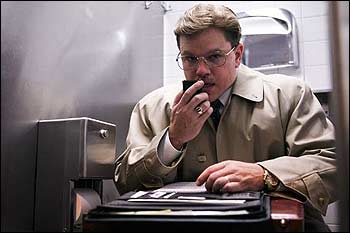 |
The Informant! is an exceptional dark comedy about a corporate whistleblower who can’t keep his mouth shut. Based upon actual events, The Informant! is the story of biochemist Mark Whitacre (Matt Damon), a brilliant but self-deluded family man who, despite taking down a global titan (Archer Daniels Midland), served a prison sentence longer than the men he helped convict. Donning a hairpiece and a cop moustache, Damon, who gained 30 pounds for the role, is as chatty and energetic as ever. Director Steven Soderbergh stages The Informant! as a zany romp, a comedy with mild thriller elements set amidst the tall corn of Decatur, Ill. It’s a pitch-perfect story about a man who is remembered not as a hero but as a tattle-tale. (9/24/09)
10. THE WHITE RIBBON
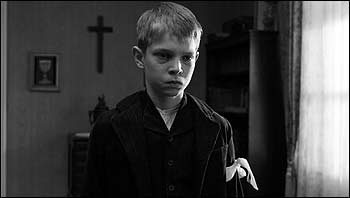 |
Imagine Children of the Corn with serious themes on its mind. In 1913, in the fictitious German village of Eichwald, children with beatific faces live in seemingly idyllic splendor. But things are not what they seem. First a doctor’s horse is killed, then a child is badly beaten; no one sees or hears anything, but the children are always nearby. Shot in color then transferred to austere black and white, The White Ribbon is a first-rate thriller as well as a psychological horror film, although everything brutal happens offscreen. The White Ribbon is oppressive, disturbing and insightful, with luminous cinematography (such as torches moving in a midnight forest) and tension aplenty. Some have found the ending fraudulent. See it to discover if you agree.
Dates in parentheses indicate the original review dates of each film. The White Ribbon and The Messenger are coming to the Bijou soon.
Molly – War movies, movies based on children’s books, satire, family drama, science fiction: I can’t find a dominant thematic trend among the films from last year that said and meant the most to me (or, in certain cases, left me with more to say than I’ve room for here). What I do see in most of these films is the thing I see in most of the stories that stay with me: They use fraught, heightened, unusual situations to explore identity — the way we become who we are; the experiences that define or challenge those identities; the ways in which place, family, work and expectations reflect and affect the people we are. There’s nothing uncommon about a year in which the best movies reflect and suggest who we’ve been, who we are and where we might be going; that’s what art does, isn’t it? But the breadth of experience cinema explores is always growing, and this year was, like each year should be, another step forward.
1. THE HURT LOCKER
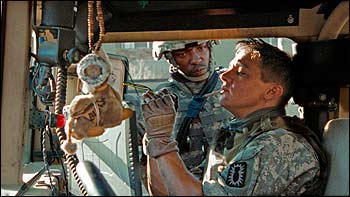 |
Unforgivingly tense, immersive and exactingly created, Kathryn Bigelow’s The Hurt Locker is a macho-as-all-hell, perfectly insular exploration of three men doing a very particular job. It’s also a movie that’s made to be seen at the movies. At home, you can push pause, back away, break the tension; in the theater you can only fidget, twitch, squirm in your seat and chew ice cubes as soldiers wait out a standoff in the middle of the desert or trace wires to deadly, unexpected devices meant only for destruction. Their job is to dismantle things; for the wrong kind of soldier, the job will dismantle the person. Will James (Jeremy Renner) isn’t a war-movie hero but a man who has found his purpose. The Hurt Locker outfits its audience with blinders — you see this job, nothing else — and insists that we not look away from the possibilities it presents. (9/3/09)
2. INGLOURIOUS BASTERDS
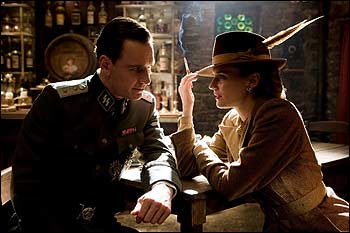 |
Quentin Tarantino’s self-proclaimed masterpiece (to what else does that last line refer?) is a wonderwork of mashups, borrowing liberally from more sources than anyone but Tarantino himself could list in full. The first scene sets the tone; as an axe looms in the foreground, Nazi officers draw near and a farmer sends his daughters into the house, the soundtrack twists expectations and teases out a giggle even as it seems such a response is out of line. Basterds is audacious, rich, absurd, suspenseful, dense and too much to take in in one viewing. It’s playing every side at once and, against the most bizarre odds, it’s winning. Brad Pitt chews consonants as the part-Apache leader of a band of Nazi-killin’ Jews; Christoph Waltz’s Col. Landa redefines the charismatic face of evil; and Mélanie Laurent, as the vengeful Shosanna, is a cinematic heroine at least twice over. In Tarantinoland, film changes the course of history. Film is, as ever, the place where the impossible happens. (8/27/09)
3. THE WHITE RIBBON
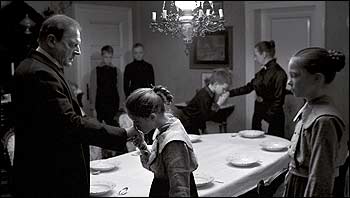 |
The White Ribbon is exquisite, disturbing and brilliant. Its black and white frames seem yanked from a different era; its actors, all unfamiliar here, could be the villagers they play. Set in Germany on the brink of WWI, The White Ribbon is, in part, a consideration of the rise of fascism as a response to repression. It’s also a sly exercise in a certain kind of genre film, and in using the art of a thing to change expectations about what it is. At the start, the narrator warns us that he didn’t personally see all of the occurrences that beset this small village. Maybe memory is reassigning blame and innocence. Maybe not. You’ll never get an easy answer from a film like this, but writer-director Michael Haneke would rather leave you with a question, whether it’s about the things people are capable of or the experiences that give them those capabilities.
4. AN EDUCATION
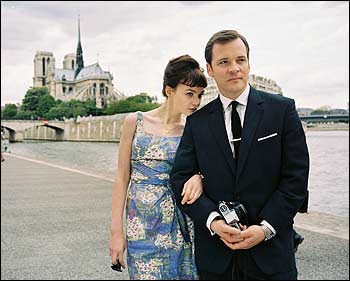 |
Sixteen-year-old Jenny (Carey Mulligan)’s affair with an older man, David (Peter Sarsgaard), seems a terrible idea, but it’s less David’s heart than his life that Jenny has in her sights. Lore Scherfig’s smart, beautiful An Education is a story about a different kind of infatuation: It’s David’s world of late dinners, clever friends, art auctions and spontaneous trips — miles from her suburban existence and endless hours spent studying for exams — that infatuates Jenny. The education Jenny receives, as she begins to understand the small compromises and larger choices that will shape her and her future, is painful, vital and wonderful. Scherfig’s film is a graceful portrait of a young woman whose experience with change comes just ahead of the transformation her country will undergo in the following years. (11/19/09)
5. BRIGHT STAR
 |
This elegiac, understated, heartbreaking film about the romance between John Keats (Ben Whishaw) and the seamstress next door, Fanny Brawne (Abby Cornish), only gently requests your attention, and thus has been overlooked. Cornish, at the very least, deserved notice for her confident, wrenching performance as Fanny. Bright Star is not a biography of John Keats; director Jane Campion often sets Fanny and her stitching front and center. As Fanny walks with John or spars with his protective housemate, Campion quietly suggests that her talents and desires, however small the world may have considered them, were no less valid than those of the two men (and far more likely to bring her an income, at that). The grief to come hovers around the edges of the lush frames as cinematographer Grieg Fraser makes the most of the English seasons. These bright, passionate young lovers can only keep autumn away so long. (10/22/09)
6. PONYO
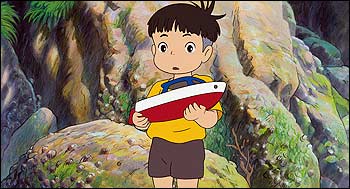 |
Like any film by the Japanese animation master Hayao Miyazaki (Spirited Away), Ponyo is utterly delightful to look at, from the small details of the home Sosuke (Frankie Jonas) shares with his mother (Tina Fey) to the elaborate underwater vessel of Fujimoto (Liam Neeson), whose inquisitive daughter Ponyo (Noah Cyrus) stirs up all kinds of trouble when she decides to use her sea-given powers to transform herself into a human. The director’s frequent ecological themes sit hand in hand with Ponyo’s lesson in personal responsibility (and her father’s struggle with letting his daughter be her own person). Miyazaki’s narratives flow like fairy tales, moving effortlessly toward resolutions that are as enthralling as they are inevitable. (8/20/09)
7. WHERE THE WILD THINGS ARE
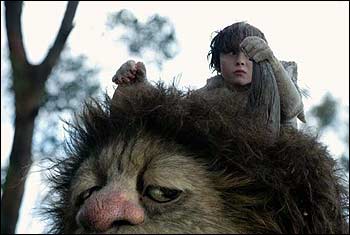 |
Spike Jonze’s misunderstood monster movie isn’t so much a movie for kids as it is a movie about remembering childhood. Jonze piled layer upon layer onto Maurice Sendak’s brief, classic book, and the result is rich and heartfelt and unabashedly strange, full of monsters who are fits of feelings made into expressive beings. Their rages and expansive love mirror the intense feelings of the kid in their midst, who uses the wild things’ world to play out the scenarios that cause him so much confusion in reality. The rumpus of the opening sequence, as Max (Max Records) and his dog careen madly about their house, is one of the most joyous explosions in film this year. (10/15/09)
8. IN THE LOOP
“Fucketty-bye.” The bite of In the Loop, a deliciously profane, ferocious political satire, takes time to register; it’s not the plot, which concerns a bunch of politicians and bureaucrats more focused on their own careers (and career suicides) than on whether their countries ought to declare war, but the personalities on display that give the film its savageness. Oneupsmanship and positioning are the game; the game almost matters more than the outcome. And the insults are cleverer than anything else these people have to offer. (8/27/09)
9. UP IN THE AIR
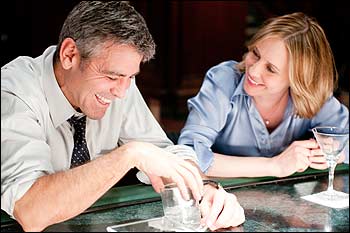 |
Up in the Air is a refreshingly grown-up movie: smart, neatly structured and filled with performances that appear so effortless, you might suspect the actors of playing themselves. Anna Kendrick plays efficiency-obsessed Natalie with respect and understanding; Vera Farmiga shines as George Clooney’s bantering equal; and Clooney, as a rootless man whose job it is to unmoor others, slips gravitas into what at first seems like another sly, built-for-him role. Like The Hurt Locker, Up in the Air focuses on a man whose way of existing in and interacting with the world is outside the norm. It’s a quieter variation than that embodied by Locker’s Will James, but it’s a difference all the same — and one that Up in the Air gracefully explores, questions, and comes to terms with. (12/31/09)
10. MOON
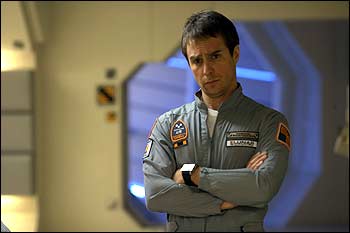 |
Sam Rockwell’s performance in Moon is up there with the year’s greats — and this was a year of great performances. In a brave, lonesome, virtually solo role, Rockwell is Sam Bell, a man finishing up his job on a lunar mining base. As the days tick by, unexpected events lead Bell to question everything he knows, right down to why he’s on the moon and who he is. Director Duncan Jones’ debut is a compact piece of science fiction that looks classic from the first scenes. It’s also a character piece on humanity, a study of what makes us, and keeps us, the people we think we are. (7/9/09)
Dates in parentheses indicate the original review dates of each film. The White Ribbon and The Messenger are coming to the Bijou soon.
THE OTHER 10
In Food, Inc. (7/23/09), the perils of our industrial food complex are presented with fresh case studies, as well as interviews with Michael Pollan and Eric Schlosser. Funny People (8/6/09) caught Judd Apatow’s fanbase off guard, delivering a mature and thoughtful (if overlong) take on mortality and reaching out to those you love. Goodbye Solo (5/28/09) is the quietly moving story of Solo (Souléymane Sy Savané), a Senegalese cab driver, and his attempts to persuade an aging man from taking his life; Solo, an unremitting optimist, is arguably the best original character this year. The Hurt Locker (9/3/09) is the story of an extremist, Sgt. James (Jeremy Renner), in the most extreme of environments, Iraq. An honorable mention top 10, The Messenger is a modest and powerful war film — in fact, it’s about the aftermath of war — in which Woody Harrelson gives a career performance as a casualty notification officer. Moon (7/9/09) is a trip worth taking if you like your sci-fi dark, paranoid and provocative, or if, like me, you’d watch Sam Rockwell read the phone book. Police, Adjective, a huge winner at Cannes last year, is about the tedious life of a Romanian narcotics official who refuses to arrest a pot-dealing teen on the grounds that it’s not worthy of a crime. A Single Man (2/4/10), the first film by fashion designer Tom Ford, is engineered to be visually perfect (almost to the point of distraction), but Colin Firth and Julianne Moore
are perfect in this tale of lost love. Up (6/4/09), the story of a man and his floating house, is another gem from Pixar; if it isn’t as immersive as Nemo or WALL-E, it’s still a moving, thrilling adventure tale. The Young Victoria (12/31/09) is frilly and recklessly romantic, but impeccably acted and full of youthful energy, particularly in the case of Emily Blunt, who is magnificent.
ELEVEN MORE
The Beaches of Agnès, Agnès Varda’s revealing, inspired scrapbook of a film, is a constantly shifting and surprising reflection on life and art. Coraline, Henry Selick’s adaptation of Neil Gaiman’s dark and magical children’s novel, uses the old-fashioned (exquisite miniatures) and the newfangled (striking 3D) to explore the tensions that rattle between children and adults, and the dangerous possibilities of hasty wishing. Gomorrah (4/9/09), as gritty as a documentary, builds its characters in increments as, in understated episodes, Matteo Garrone’s Italian crime film examines the way violence, fear and poverty transform lives. Goodbye Solo (5/28/09) is the surprisingly fresh, affecting, quiet story of two very different men coming to understand each other. Bent Hamer’s delightfully dry, restrained O’Horten (8/20/09) follows a train engineer whose neatly scheduled life goes off the rails after he retires. Colin Firth inhabits A Single Man (2/4/10), director Tom Ford’s adaptation of Christopher Isherwood’s short novel about love and grief, in a way that overshadows every other leading performance this year. Star Trek (5/14/09), District 9 (8/20/09) and Avatar (12/24/09) all have undeniable failings that have been as hotly debated as their remarkable strengths (if not more so), but together with the unassuming Moon, they constitute an incredible year
of promise for science fiction (if one that makes it as clear what needs reconsidering as what looks freaking awesome). The elegant dialogue and dreamy closing scenes of Olivier Assayas’ Summer Hours (7/30/09), a languid, humid French family drama about memory, meaning, art and culture, lingered longer than expected. Up (6/4/09) pushes many of my buttons, not least the one that reacts to stories that consider the tales we tell ourselves about our lives, and how they might contrast with — or enrich — the lives we’ve actually lived.